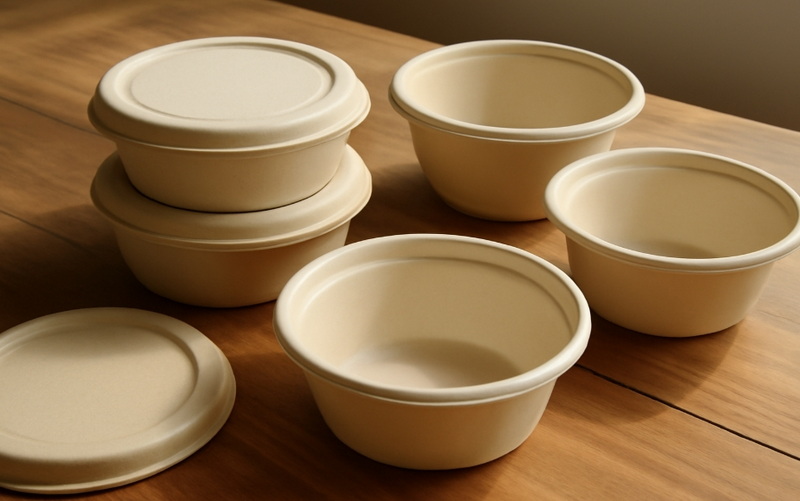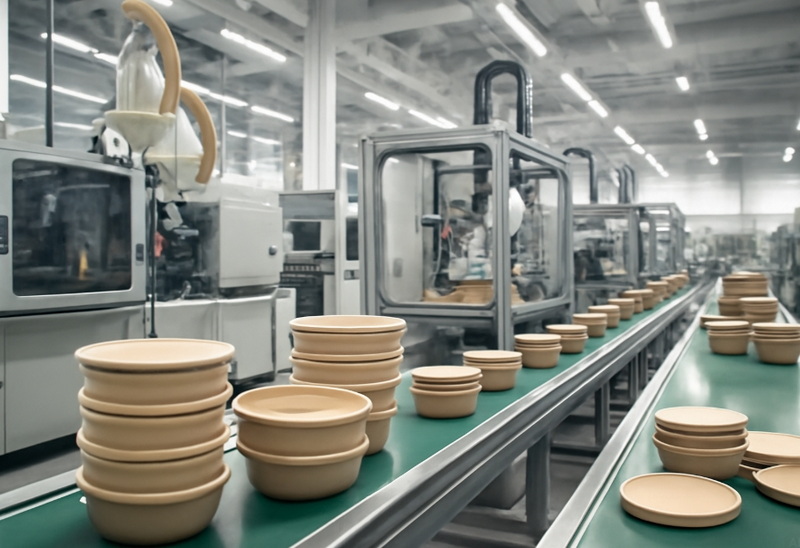
Content Menu
● Overview of Bowl And Lid Manufacturing
● Common Materials in Bowl And Lid Manufacturing
>> Paper-Based Materials
>> Plastic Materials
>> Stainless Steel
>> Glass
>> Ceramic and Pottery
>> Wood
>> Melamine
● Manufacturing Processes in Bowl And Lid Manufacturing
● Sustainability and Environmental Considerations
● Conclusion
● Frequently Asked Questions
>> 1. What are the most common materials used in Bowl And Lid Manufacturing?
>> 2. How are plastic bowls and lids manufactured?
>> 3. What makes stainless steel a popular choice for bowls in professional kitchens?
>> 4. Are paper-based bowls and lids environmentally friendly?
>> 5. How are wooden bowls and lids made?
Bowl And Lid Manufacturing is a vibrant and essential sector within packaging and food service industries. The process involves selecting materials and production methods that ensure product safety, durability, and user satisfaction. This article delves into the variety of materials used in Bowl And Lid Manufacturing, their manufacturing processes, and the latest trends in sustainability and innovation.

Overview of Bowl And Lid Manufacturing
Bowl And Lid Manufacturing serves a broad range of applications, from disposable food containers to premium homeware. The choice of material is pivotal, influencing everything from product performance to environmental impact. Manufacturers must balance cost, functionality, and ecological responsibility while meeting regulatory standards for food safety.
Common Materials in Bowl And Lid Manufacturing
Paper-Based Materials
Paper-based materials are among the most widely used in Bowl And Lid Manufacturing, especially for single-use products. These materials are valued for their versatility, cost-effectiveness, and growing environmental appeal.
- Kraft Paper: Recognized for its strength and natural appearance, kraft paper is commonly used in food packaging. It is made from virgin pulp and is suitable for direct food contact when properly treated.
- Virgin Pulp: This material offers a smooth, bright surface, making it ideal for branding and high-quality printing. It is often chosen for its clean look and reliable performance.
- Recycled Paper: Using recycled paper supports environmental sustainability by reducing waste. While it may not always be suitable for direct food contact, it is widely used for eco-friendly packaging solutions.
- Specialty Fibers: Materials such as bamboo and sugarcane fibers are gaining popularity. Bamboo is strong, flexible, and biodegradable, while sugarcane is a renewable resource that supports sustainable manufacturing.
To prevent leaks and maintain structural integrity, paper bowls and lids are often coated with barrier materials such as polyethylene (PE), polypropylene (PP), polylactic acid (PLA), or water-based coatings. These coatings make the products suitable for a variety of foods, including liquids and greasy items.
Plastic Materials
Plastics remain a cornerstone of Bowl And Lid Manufacturing due to their versatility, lightweight nature, and low production costs. Different types of plastics are selected based on the intended use and performance requirements.
- Polypropylene (PP): This plastic is highly resistant to heat, moisture, and chemicals, making it ideal for food service applications. It is commonly used for both bowls and lids.
- Polystyrene (PS): PS is a rigid plastic that can be molded into various shapes, making it suitable for lids. It is cost-effective and provides clarity, though it is less heat-resistant than PP.
- Polyethylene Terephthalate (PET): Known for its strength and clarity, PET is often used for cold food containers and hinge-style lids.
- Other Plastics: Acrylonitrile-Styrene (AS), Acrylonitrile Butadiene Styrene (ABS), and Thermoplastic Elastomer (TPE) are used for specialized components such as buttons or soft-touch features in lids.
Plastic bowls and lids are typically produced using injection molding or thermoforming, enabling high-volume production and precise design.
Stainless Steel
Stainless steel is a premium material choice in Bowl And Lid Manufacturing, particularly for professional kitchens and heavy-duty applications.
- Durability: Stainless steel is highly resistant to impact, corrosion, and wear, making it suitable for repeated use.
- Hygiene: Its smooth surface is easy to clean and disinfect, reducing the risk of bacterial growth.
- Heat Resistance: Stainless steel can withstand high temperatures, making it ideal for cooking and serving hot foods.
Stainless steel bowls are manufactured through processes such as stamping, deep drawing, and polishing. Lids are often made from the same material or compatible plastics for airtight sealing.
Glass
Glass is a classic and elegant material in Bowl And Lid Manufacturing, valued for its transparency and inertness.
- Raw Materials: Silica sand, soda ash, and limestone are melted together to form molten glass.
- Forming: The molten glass is shaped using molding, blowing, or casting techniques.
- Annealing: After forming, the glass is slowly cooled to relieve internal stresses and enhance durability.
- Finishing: Additional processes such as polishing or etching may be applied for aesthetic purposes.
Glass lids are less common but can be found in some specialty applications. More often, glass bowls are paired with plastic or silicone lids for convenience and safety.
Ceramic and Pottery
Ceramic and pottery bowls are celebrated for their aesthetic appeal and traditional craftsmanship.
- Clay Preparation: Clay is shaped on a pottery wheel to form the bowl.
- Firing: The shaped clay is fired in a kiln at high temperatures to harden it.
- Glazing: A glaze is applied for decoration and to make the bowl waterproof.
- Final Firing: The glazed bowl is fired again to fuse the glaze and complete the process.
Ceramic lids are often custom-made to fit specific bowls, especially for storage or decorative purposes.
Wood
Wooden bowls and lids are appreciated for their natural beauty and rustic charm.
- Wood Selection: Hardwoods such as maple, cherry, or sycamore are commonly used.
- Turning: The wood is shaped on a lathe to create the bowl and lid.
- Finishing: The finished pieces are sanded and treated with food-safe oils or waxes.
Wooden lids are typically made to fit snugly over the bowl, providing an attractive and functional closure.
Melamine
Melamine is a durable plastic resin molded into bowls and lids. It is known for its scratch resistance, vibrant colors, and lightweight nature.
- Durability: Melamine is resistant to breakage, making it popular in both household and commercial settings.
- Versatility: It can be molded into various shapes and designs, supporting a wide range of applications.

Manufacturing Processes in Bowl And Lid Manufacturing
The manufacturing process varies depending on the material:
- Paper-Based Products: Paper pulp is formed into the desired shape using molds and then coated with a barrier layer. Lids are often produced using similar processes or through thermoforming of plastic films.
- Plastic Products: Injection molding and thermoforming are the most common methods, enabling complex shapes and high-volume production.
- Stainless Steel: Sheets of stainless steel are stamped and deep-drawn into bowl shapes, then polished and finished. Lids may be made from the same material or compatible plastics.
- Glass: Molten glass is shaped using molds or blowing techniques, then annealed and finished.
- Ceramic/Pottery: Clay is shaped on a wheel, fired, glazed, and fired again.
- Wood: Wood is turned on a lathe, sanded, and finished with food-safe treatments.
- Melamine: Melamine resin is molded into shape and cured under heat and pressure.
Sustainability and Environmental Considerations
Sustainability is increasingly important in Bowl And Lid Manufacturing. Manufacturers are adopting eco-friendly practices such as using biodegradable coatings, recycled materials, and renewable fibers. Innovations in bio-based plastics and compostable packaging are also gaining traction, helping to reduce the environmental footprint of these products.
Conclusion
Bowl And Lid Manufacturing is a dynamic industry that utilizes a wide range of materials to meet diverse consumer needs. From paper and plastic to stainless steel, glass, ceramic, wood, and melamine, each material offers unique advantages in terms of durability, safety, and environmental impact. The manufacturing processes are tailored to the properties of each material, ensuring high-quality products for food service, home use, and specialty applications. As sustainability becomes a priority, manufacturers are embracing innovative materials and practices to reduce waste and support a greener future. Understanding the materials and processes involved in Bowl And Lid Manufacturing empowers consumers and businesses to make informed choices that align with their values and requirements.

Frequently Asked Questions
1. What are the most common materials used in Bowl And Lid Manufacturing?
The most common materials include paper (kraft, virgin pulp, recycled, and specialty fibers), plastics (PP, PS, PET), stainless steel, glass, ceramic/pottery, wood, and melamine. Each material is chosen for its specific properties, such as durability, heat resistance, or environmental impact.
2. How are plastic bowls and lids manufactured?
Plastic bowls and lids are typically produced using injection molding or thermoforming processes. These methods allow for high-volume production and precise shaping, making them cost-effective for food service and household applications.
3. What makes stainless steel a popular choice for bowls in professional kitchens?
Stainless steel is highly durable, resistant to corrosion and impact, easy to clean, and can withstand high temperatures. These properties make it ideal for heavy-duty use in professional kitchens.
4. Are paper-based bowls and lids environmentally friendly?
Paper-based bowls and lids can be environmentally friendly, especially when made from recycled or renewable fibers and coated with biodegradable or compostable materials. However, the environmental impact depends on the specific materials and coatings used.
5. How are wooden bowls and lids made?
Wooden bowls and lids are crafted by turning selected hardwoods on a lathe. The finished pieces are sanded and treated with food-safe oils or waxes to protect the wood and enhance its appearance.

















